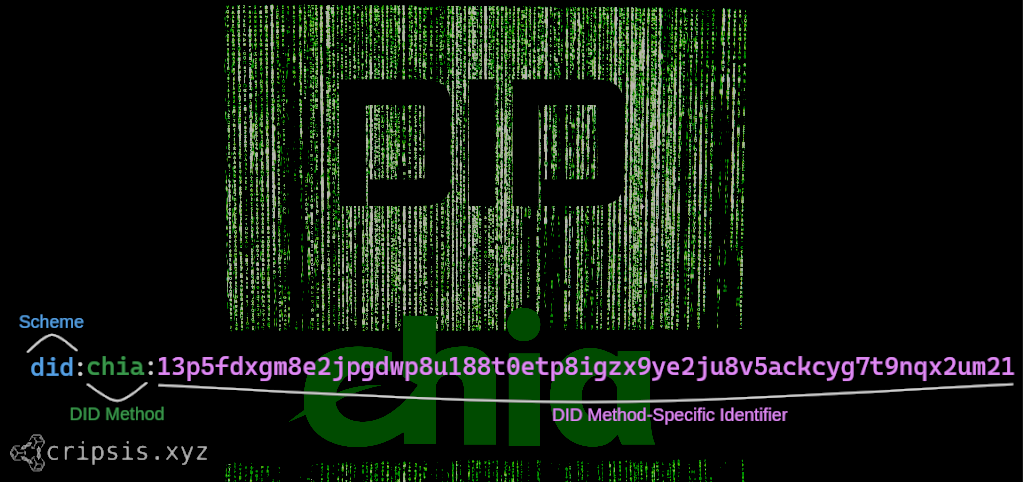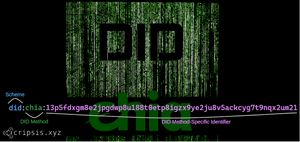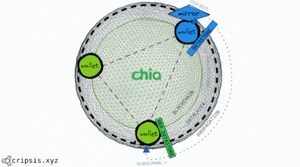Introduction
Many times we have heard the acronym DID, but do you really know what it is for?
Welcome to this new article, where we will dive into the world of Decentralized Identifiers, or DID. Today, we will explore not only the fundamentals of this technology, but also how Chia , the green cryptocurrency, uses DIDs in its ecosystem .
Chia, known for its innovations in blockchain technology, has already implemented DIDs in the past; a secure and decentralized way to manage identity online.
This technology is not only exciting in terms of security and privacy, but also opens doors to new ways of interacting online. And when we combine it with Chia, the possibilities are even more powerful.
General Use of DIDs in Blockchains
Decentralized Identifiers (DIDs) are transforming the way we interact online.
A DID acts as a bridge between the user and the blockchain , allowing the user to perform tasks such as authentication, credential verification, and personal data management without having to deal directly with the blockchain.

- User: The person or entity that uses a DID.
- DID: The system for creating and managing decentralized identifiers.
- Blockchain: The technology that records and confirms DIDs.
- Service: Represents the authentication and access to online services.
- Verification: Symbolizes the verification of credentials and consents.
- Data: Represents the management and control of personal data.
What exactly are DIDs?
DIDs allow us to control our online identity in a decentralized way. Think of them as your digital identity card, but where you have full control.
Structure of the URI of a DID
A DID URI is basically the unique address that identifies an entity in the decentralized digital world. Think of it like someone's email address or phone number, but in the context of blockchain technology.
The URI of a DID is made up of three main parts:
- Scheme : It will always start with "did:" to indicate that it is a Decentralized Identifier.
- Method : Next, we find the method, which specifies the blockchain technology or protocol that is used. It could be something like "ethereum" or "chia".
- Identifier : Finally, there is a unique string that represents the entity itself, such as a wallet or a user. This string is unique within the specified method and points to entity information on that particular blockchain.

did: Indicates that the URI is a Decentralized Identifier, a standard for identifiers that are not tied to a centralized authority.chia: The method or blockchain network associated with the DID, indicating that the identifier belongs to the Chia network.13p5fdxgm8e2png...: The unique identifier of the wallet within the Chia network.
Therefore, this specific DID represents a unique wallet on the Chia blockchain, and can be used to authenticate and access the wallet, manage its assets, perform transactions, and other related purposes.
The Technology behind DID
Using blockchain technology, DIDs provide a transparent and secure way to register and verify identity without revealing sensitive data.
Applications and Use
- Authentication: A secure, password-free way to access online services.
- Credential Verification: Check titles, certifications and skills without intermediaries.
- Consent Management: Control who has access to your personal data and how it is used.
- Secure Data Exchange: Share information in a secure and controlled manner between parties.
- Digital Notarization: Create reliable and verifiable records of documents and transactions.
This uniqueness makes it possible to isolate and manage identity securely and efficiently, ensuring that each entity has full control over their information and how it is shared.

Interoperability between blockchains
Imagine that blockchains are like different highway systems in different countries. Each has its own rules and signs, and it is not always easy to drive from one country to another. This is where Decentralized Identifiers or DIDs come in, acting as a universal GPS that allows you to seamlessly navigate all of these road systems.

- Uniform Standard: DIDs provide a common rule that is recognizable and usable on different blockchains.
- Cross-Platform Authentication: DIDs enable a form of authentication and access control that can be used across multiple networks, keeping data and identity secure.
- Support for Multiple Methods: DIDs are customizable and can be adjusted to different blockchain technologies.
- Make Portability Easy: With DIDs, you can easily move from one network to another, without hassle or delay.
- User Control and Privacy: DIDs give you full control over your identity on different networks.
- Facilitates the Composition of Services: DIDs allow access to different services and destinations without having to leave the system.
- Reduced Fragmentation: DIDs make everyone play by the same rules, simplifying movement between different networks.
- Challenges and Considerations: There are obstacles and bumps in the road that need to be addressed in DID implementation, but they are being worked on.
Use of DIDs in Chia
DIDs in Chia provide a way to manage decentralized identities, offering full user control over their identity and associated data. Its Chia integration enables a variety of applications, including authentication, asset management, linking with NFTs, and more.
DID Wallet vs Traditional Wallet
DID Wallet for the Transfer of NFTs :
- Advanced Control: The DID wallet allows for more precise ownership management and control over NFTs. You can include custom rules and conditions that determine how NFTs can be transferred.
- Interoperability: The DID wallet is designed to be compatible with different standards and blockchains, facilitating the transfer of NFTs between different systems.
- Enhanced Security: DID-based authentication and authorization adds an extra layer of security to NFT transfers, which can reduce the risk of attacks and fraud.
Traditional Wallet :
- Simpler: A traditional wallet is used to manage funds and basic token transfers, but may lack the flexibility and advanced functionality needed to manage complex NFTs.
Why Use DID Wallet Instead of Traditional Wallet
- Flexibility: The DID wallet allows greater customization and adaptability in the management of NFTs, including the definition of custom rules and transfer conditions.
- Improved Privacy: The DID wallet can offer better control over privacy and access to personal information.
- Facilitates Decentralized Authentication: Enables secure authentication without the need for a centralized third party, which is critical in unique asset transfers like NFTs.
- Alignment with Decentralized Principles: The DID wallet is in line with the principles of decentralization and self-sovereignty that are fundamental in Chia and in the blockchain philosophy in general.
In summary, the use of the DID wallet instead of the traditional wallet in the transfer of NFTs in Chia is due to the greater flexibility, control, security and alignment with the decentralized principles that it provides. It allows for more advanced and personalized management of NFTs and other digital assets, improving the user experience and expanding the possibilities within the Chia ecosystem.
Conclusion
That has been all in this introduction to Decentralized Identifiers (DID) and their role in interoperability in the world of blockchains. If you're interested in going even deeper, especially about how DIDs are used in the Chia ecosystem, make sure you don't tune out. There are many exciting and advanced aspects to explore in this ever-evolving field. Until next time!
Creating and sharing quality content takes time and effort. If you appreciate my work and would like to see more of it, please consider making a small donation.
Every contribution, however small, makes a big difference and helps me continue this work that I enjoy so much.
If you have any kind of suggestion or would like me to talk about a specific topic, let me know!









